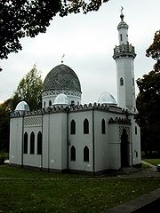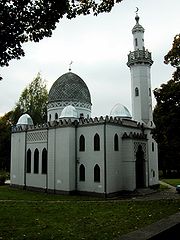
Islam in Lithuania
Encyclopedia

Lithuania
Lithuania , officially the Republic of Lithuania is a country in Northern Europe, the biggest of the three Baltic states. It is situated along the southeastern shore of the Baltic Sea, whereby to the west lie Sweden and Denmark...
, unlike many other northern and western European countries, Islam came long ago. It was so because the medieval Grand Duchy of Lithuania
Grand Duchy of Lithuania
The Grand Duchy of Lithuania was a European state from the 12th /13th century until 1569 and then as a constituent part of Polish-Lithuanian Commonwealth until 1791 when Constitution of May 3, 1791 abolished it in favor of unitary state. It was founded by the Lithuanians, one of the polytheistic...
of the Polish–Lithuanian Commonwealth, stretching from Baltic to Black seas, included some Muslim lands in the south, inhabited by Crimean Tatars
Crimean Tatars
Crimean Tatars or Crimeans are a Turkic ethnic group that originally resided in Crimea. They speak the Crimean Tatar language...
. Some of people from those lands were moved into ethnically Lithuanian lands, now the current Republic of Lithuania, mainly under rule of Grand Duke Vytautas
Vytautas the Great
Vytautas ; styled "the Great" from the 15th century onwards; c. 1350 October 27, 1430) was one of the most famous rulers of medieval Lithuania. Vytautas was the ruler of the Grand Duchy of Lithuania which chiefly encompassed the Lithuanians and Ruthenians...
. The Tatars, now referred to as Lithuanian Tatars, lost their language over time and now speak Lithuanian
Lithuanian language
Lithuanian is the official state language of Lithuania and is recognized as one of the official languages of the European Union. There are about 2.96 million native Lithuanian speakers in Lithuania and about 170,000 abroad. Lithuanian is a Baltic language, closely related to Latvian, although they...
as natives; however, they have not lost Islam as their religion. Due to long isolation from all the other Islamic world, the practices of the Lithuanian Tatars differs somewhat from the rest of Sunni Muslims; they are not considered a separate sect however.
In Lithuania, unlike many other European societies at the time, religious freedom was pursued. Lithuanian Tatars settled in certain places, such as around Raižiai (in Alytus district municipality
Alytus district municipality
The Alytus district municipality is a municipality in Lithuania, located in the Dzūkija ethnographic region.This municipality was founded in 1950, and until 1953 was a part of the Kaunas province. In 1959, another reorganization of parts of the former Simnas and Daugai municipalities occurred,...
).
Much of the Lithuanian Tatar culture, mosques, graveyards and such were destroyed by the Soviet Union
Soviet Union
The Soviet Union , officially the Union of Soviet Socialist Republics , was a constitutionally socialist state that existed in Eurasia between 1922 and 1991....
after it annexed Lithuania. After restoration of Lithuanian independence however the government supported the promotion of Lithuanian Tatar culture among those Lithuanian tatars who lost it. Three original wooden mosques remain now (in villages of Nemėžis
Nemežis
Nemėžis is a village in the Vilnius district municipality, Lithuania. It is located south-east of Vilnius along a railway.- History:It is believed that there was a castle in Nemėžis during the reign of Vytautas the Great...
, Keturiasdešimt Totorių (both in Vilnius district municipality
Vilnius district municipality
Vilnius district municipality is one of 60 municipalities in Lithuania. It surrounds the capital on 3 sides, and the Trakai district municipality touches it on one....
) and Raižiai (Alytus district municipality
Alytus district municipality
The Alytus district municipality is a municipality in Lithuania, located in the Dzūkija ethnographic region.This municipality was founded in 1950, and until 1953 was a part of the Kaunas province. In 1959, another reorganization of parts of the former Simnas and Daugai municipalities occurred,...
), typically having relatively large Muslim populations), as well as a new brick mosque built in Kaunas
Kaunas
Kaunas is the second-largest city in Lithuania and has historically been a leading centre of Lithuanian economic, academic, and cultural life. Kaunas was the biggest city and the center of a powiat in Trakai Voivodeship of the Grand Duchy of Lithuania since 1413. During Russian Empire occupation...
during the period of interwar independence of Lithuania (in the 30s) to commemorate the anniversary of Vytautas, the duke who brought Tatars and Islam to Lithuania. That mosque is called Vytautas Didysis Mosque
Kaunas Mosque
Kaunas Mosque or Vytautas the Great Mosque is one of four remaining mosques in Lithuania. It is located in Centras eldership, Kaunas. It is the only brick mosque in Lithuania....
after the Grand Duke Vytautas
Vytautas the Great
Vytautas ; styled "the Great" from the 15th century onwards; c. 1350 October 27, 1430) was one of the most famous rulers of medieval Lithuania. Vytautas was the ruler of the Grand Duchy of Lithuania which chiefly encompassed the Lithuanians and Ruthenians...
. In the capital of Lithuania, Vilnius
Vilnius
Vilnius is the capital of Lithuania, and its largest city, with a population of 560,190 as of 2010. It is the seat of the Vilnius city municipality and of the Vilnius district municipality. It is also the capital of Vilnius County...
, however, no mosque remains, as Russians destroyed the Lukiškės Mosque which was there. The Lithuanian Tatar community is trying to rebuild the mosque, but faces various problems, including lack of funds as well as certain actions by the government of Vilnius city municipality
Vilnius city municipality
The Vilnius city municipality , is one of 60 municipalities in Lithuania. It is in the southeastern part of country, in Vilnius County and consists of the city of Vilnius, the town of Grigiškės and some rural areas.- History :...
.
Currently, only several thousand Lithuanian Tatars remain; however, with the restoration of Lithuanian independence, they are experiencing a kind of national revival.
During the time of the Soviet Union, some people from other Muslim nationalities were moved in, however many of them were atheists; as well other Muslims came as immigrants after restoration of independence, but as for now this number is very small compared to similar numbers in western Europe; therefore for now Lithuanian Tatars remain the core of Islam in Lithuania, supported by some Lithuanians who converted. Overall, there are less than 3000 Muslims in Lithuania according to the last census held in 2001.
External links
Websites of Lithuanian Muslims:- http://www.islamas.lt
- http://www.musulmonai.lt
- http://mosqueedelituanie.over-blog.com (explanations in French language and a lot of photos of the different mosques)

